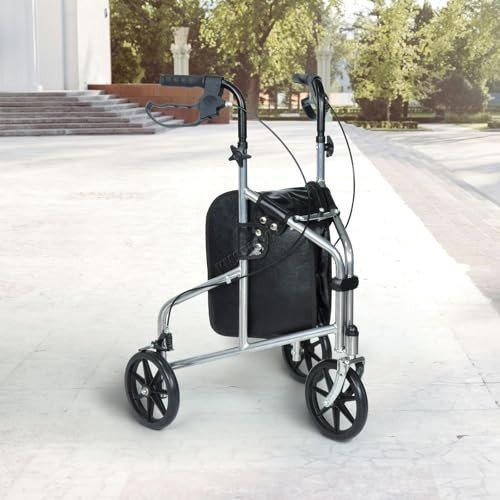
4
May20 Myths About Rollator With Brakes: Busted

Understanding Rollators with Brakes: A Comprehensive Guide
As people age or experience mobility obstacles, daily tasks can end up being progressively hard. A rollator with brakes is a mobility aid created to enhance independence and safety for users. These tools not only supply assistance while walking however also come geared up with brakes that ensure stability and control. This article looks into the functions, benefits, and factors to consider for selecting a rollator with brakes, together with often asked concerns to help potential users make informed decisions.
What is a Rollator?
A rollator is a mobility aid that generally consists of a wheeled frame with handgrips, a seat, and, most notably, brakes. Created for people who require some support while walking, rollators supply stability, assistance, and a hassle-free method to rest when required.
Secret Features of Rollators
- Wheels: Most rollators have 4 wheels, which allow smoother movement over various terrains.
- Brakes: Handles connected to brakes allow users to control speed and stop safely when required.
- Seat: An integrated seat uses a choice for users to rest when tired out.
- Storage: Many designs include baskets or pouches for bring individual products.
Benefits of Using a Rollator with Brakes
Utilizing a rollator with brakes provides numerous benefits, consisting of:
- Enhanced Safety: The brakes provide stability, preventing falls.
- Self-reliance: Users can move about without help, promoting autonomy.
- Convenience: Built-in storage permits individuals to carry their belongings quickly.
- Flexibility: Suitable for both indoor and outdoor use.
Kinds of Rollators with Brakes
Rollators are available in various styles to accommodate various user requirements. The following prevail kinds of rollators with brakes:
- Standard Rollators: Equipped with four wheels, these appropriate for the majority of users who need standard assistance.
- Heavy Duty Bariatric 4-Wheel Walker with Seat-Duty Rollators: Designed for bigger people, these rollators come with reinforced frames to supply reliable assistance.
- Compact Rollators: DeVilbiss Lightweight Blue Rollator - Comfort & Style and foldable, compact rollators are ideal for travel.
- Three-Wheel Rollators: A versatile option for maneuvering tight areas, three-wheel designs provide ease of motion.
| Type of Rollator | Secret Features | Best Suited For |
|---|---|---|
| Requirement Rollator | Four wheels, fundamental functionality | General users |
| Sturdy Rollator | Enhanced frame, durable materials | Bigger people |
| Compact Rollator | Lightweight Four-Wheeled Rollator for Easy Mobility, foldable style | Travel and portability |
| Three-Wheel Rollator | Smaller sized turning radius, simple mobility | Limited areas |
Aspects to Consider When Choosing a Rollator with Brakes
Choosing the ideal rollator requires consideration of numerous factors. Here are necessary aspects to keep in mind:
- Weight Capacity: Verify the rollator's weight limit to ensure it is safe for the user.
- Handle Height: Adjustable manages enable personalization to match specific height requirements.
- Wheel Size: Larger wheels perform better on uneven surfaces, while smaller sized wheels offer agility in tight spaces.
- Folding Ability: If travel is a factor to consider, search for a design that is simple to fold and store.
- Braking Mechanism: Different designs may feature different braking systems (e.g., push-to-lock, pull-to-release). Pick one that aligns with user convenience.
Maintenance Tips for Rollators with Brakes
Correct upkeep guarantees durability and optimum efficiency. Follow these guidelines to keep a rollator in exceptional condition:
- Regular Cleaning: Wipe down the frame and check for built up dirt and debris.
- Inspect Wheels: Ensure wheels are complimentary from blockage and are correctly pumped up if pneumatic.
- Test Brakes: Regularly check if brakes engage and disengage efficiently.
- Change Handles: Make regular modifications to guarantee the deal with height remains appropriate for the user.
Frequently Asked Questions (FAQs)
Q1: Are rollators suitable for outdoor use?A1: Yes
, lots of rollators are developed for both indoor and outdoor use. Those with bigger wheels tend to carry out better on unequal surfaces.
Q2: Can rollators fold for easy storage?A2: Most rollators include a folding feature, making them simple to store Panana 4-Wheel Rollator: Comfortable and Portable Support transport. Q3: How do I understand if a rollator is
safe for me?A3: Ensure the weight capacity meets your requirements,
and change the manage height for proper ergonomics. Consulting a doctor for suggestions is also a good idea. Q4: Can I use a rollator with brakes on stairs?A4: Rollators are not developed
for use on stairs. For stair navigation,
individuals ought to look for other techniques of support, like handrails or stair lifts. Q5: How do I care for a rollator with brakes?A5: Regular cleaning, examining for wear and tear, and inspecting the braking system are important steps for maintenance. Rollators with brakes represent a necessary mobility aid for people seeking improved independence and safety. As users evaluate their options
, understanding the different types, features, and upkeep requirements will guarantee they choose the very best rollator for their requirements. With correct care and usage, a rollator can substantially boost one's mobility, adding to better lifestyle and greater liberty in everyday activities.
Reviews